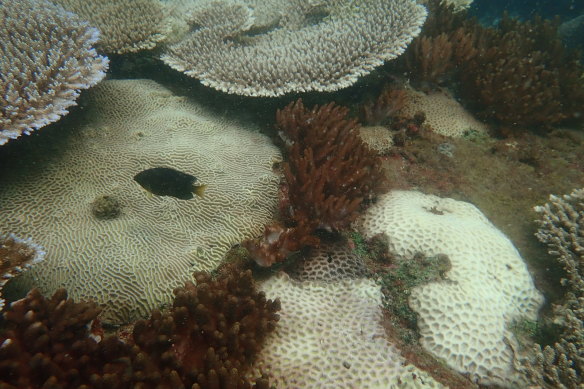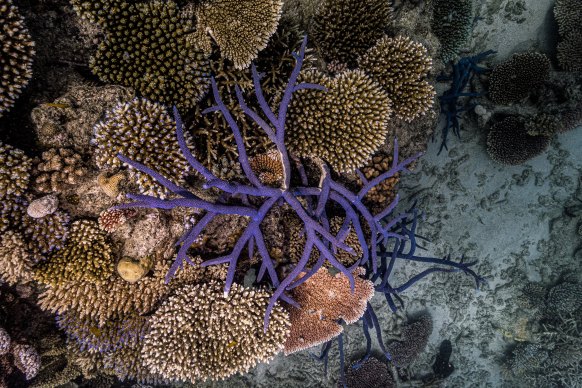This was published 1 year ago
Record temperatures cause new Great Barrier Reef bleaching
By Laura Chung
Large parts of the Great Barrier Reef have been bleached as ocean temperatures soar above average as scientists fear conditions will worsen in coming weeks.
Scientists had hoped that two tropical cyclones might keep waters cool enough to protect the reef from record temperatures, but during routine surveys, James Cook University’s Centre for Tropical Water and Aquatic Ecosystem Research scientist Dr Maya Srinivasan and her team detected moderate to severe bleaching around the Keppel Islands.

Scientists monitored 27 sites in the Great Barrier Reef and found moderate to severe coral bleaching. Credit: James Cook University, Centre for Tropical Water and Aquatic Ecosystem Research
“Once we were in the water, we could instantly see parts of the reef that were completely white from severe bleaching. Some corals were already dying,” she said. “We have seen fish abundance decline as coral cover declines in this region following past impacts like this.”
But other parts of the reef are also showing signs of bleaching. More than 1000 kilometres away on Lizard Island, bleaching is the worst it’s been in five years.
Coral bleaching occurs when underwater temperatures are more than 1 degree warmer than the long-term average, which causes heat stress. If this persists for a few weeks, it can cause coral bleaching.
Australian Museum’s Lizard Island Research Station joint director Dr Anne Hoggett said they first noticed signs of bleaching in late February, but over the past few weeks it’s gotten worse. She said temperatures are up to 31 degrees and don’t show any signs of cooling down.
Coral in the shallow areas of Lizard Island are showing signs of bleaching and within days could have passed a point of recovery, Hoggett said. She fears the deeper parts of the reef, up to 18 metres, will start to bleach the longer the warm temperatures linger.
“It’s pretty sad,” she said. “There’s been bleaching many times since the big event in 2016, but none of them have progressed as much as this one.”
The past eight years have been filled with coral bleaching events along the Great Barrier Reef, with the worst one occurring in 2016. The 2021 and 2022 summer was the first time the reef had bleached during a La Nina year.
The outlook for the Great Barrier Reef over the summer looked grim, and reef scientists were concerned. After all, coral reefs in the Northern Hemisphere were bleached in the worst event just months earlier – up to 95 per cent of corals they surveyed at 76 sites across the Florida Keys and Dry Tortugas over a week showed signs of extreme bleaching.
As Australia’s summer drew closer, reef scientists were concerned the same thing would occur along the Great Barrier Reef. But when two tropical cyclones occurred, the concern subsided - slightly, WWF Australia head of oceans Richard Leck said.
But as the summer months drew closer and two tropical cyclones occurred, the threat of heat stress and coral bleaching minimised. While tropical cyclones pose their own risk to coral reefs, Leck added.
“The consensus was that we got through another season without a major bleaching event. Then all of a sudden, it feels like we are on a knife’s edge,” he said.
“We have got really concerning high temperatures over a large part of a Great Barrier Reef and we still have a large number of weeks to get through before temperatures traditionally cool down.

In 2022, the Herald visited Lizard Island and saw how much the reefs had recovered since the 2016 bleaching event. Credit: Brook Mitchell
“We shouldn’t be having the threat of a mass coral bleaching this year.”
“The advice has always been when you have big storms like we’ve had, you traditionally don’t get coral bleaching. The conditions are changing.”
Bleaching is forecast to reduce global coral cover by 95 per cent under 2 degrees of warming, and 70 per cent under 1.5 degrees. If all countries deliver on their climate commitments, the world would still be on track for 2 degrees or more of warming. If the rest of the world followed Australia’s current commitments and policies, global warming would exceed 3 degrees, according to Climate Action Tracker.
But Leck said that recent actions from the federal and local governments were cause for hope, but more needed to be done as climate change continues to warm the environment, placing more stress on coral reefs.
Srinivasan added that despite the bleaching she’d witnessed, coral reefs could recover.
“There just needs to be enough time between impacts to allow this recovery to occur,” she said.
A guide to the environment, what’s happening to it, what’s being done about it and what it means for the future. Sign up to our fortnightly Environment newsletter here.